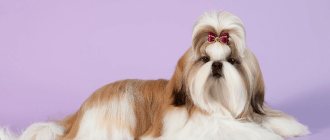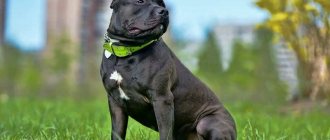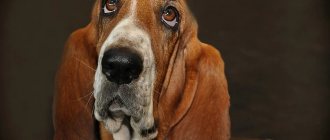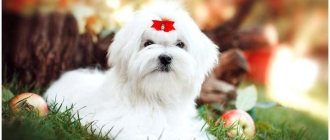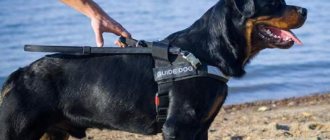History of the breed
The Belgian and Brussels Griffons, as well as the Petit Brabançon, are part of the Belgian small dogs group. Griffons are a wire-haired species with thick eyebrows and a beard. The Petit Brabançon is a smooth-haired baby without a beard or mustache. He also falls into the shorthair category.
The entire group is descended from the local smousje dog, which was kept on farms to hunt rats. The Belgian variety is the result of crossing a Smousje and a Cavalier King Charles Spaniel. In the course of further selection, the “Belgians” were bred with Affenpinschers, Yorkies, dwarf schnauzers and pugs.
Mini dogs spread to Belgium in the 15th century and were loved by ladies from high society. They began to be used as a fashion accessory when going out. There are dozens of paintings by Belgian artists depicting ladies with griffins.
This breed was also used for hunting rats. A few miniature dogs could clear an entire farm of rodents. However, their sweet faces with human expression turned them into completely decorative dogs.
"The Belgians" was presented to the public in 1880. The first breed standard dates back to 1904. Since then, it has been rewritten several times: the last edition dates back to 2003.
Translated from French, “griffon” means “wiry-haired.”
Description of the breed
The Belgian Griffon is a miniature, square-shaped dog with strong bones and an expressive muzzle. Its highlight is the human features of the “face”. This provides a constant reason for jokes and affection.
Breed standard:
- Dimensions: height does not have a standard, but averages range from 26 to 32 cm; weight: 3.5 – 6 kg.
- The head is large, with a rounded skull and convex forehead. A pronounced transition from the forehead to the muzzle.
- The nose is colored black. The nostrils are well cut.
- The lips are black, dense, and fit well together.
- The lower jaw is curved upward, slightly protruding beyond the upper. Snack.
- The eyes are quite large, round, but not protruding. Widely spaced. The iris is dark brown. Stroke black.
- The ears are miniature, high-set. Cropped and natural options are allowed. Uncropped ears should hang forward and not to the side.
- The neck is moderately long, gently blending into the withers.
- The back is short, strong, with a slightly convex loin.
- The chest is quite wide, with a pronounced sternum.
- The tail is high set, raised to the top. Cropped and natural options are allowed. In the first case, 2/3 of the usual length is left. A curled, short, broken tail is a defect in accordance with the standard.
- The limbs are parallel, with strong bones. The paws are neat and small. The shape is round.
The coat is hard, with a slight wave, and requires regular trimming. The face has characteristic eyebrows, beard and mustache. The cheekbones and muzzle are covered with long, thick hair. Soft, silky six is unacceptable by the standard.
Colors
The Belgian Griffon has only two color options: black and black and tan. The spots must be a clean, uniform color. A small amount of white chest hair is acceptable. White spots are considered a violation of the standard.
How to care for a dog
Caring for a pet is easy, as griffons are clean. Particular attention should be paid to the dog's coat. For example, during the molting period, be sure to do trimming and comb the fur once a week using a furminator. The Griffon, which has a coarse coat, sheds much less. To remove dead hairs, you should sometimes pluck them.
In order for walking your animal to bring him positive emotions, you must buy a leash and harness. These accessories are chosen according to the size of the pet. 2 fingers should fit under the fastened collar. Only in this case will the dog be comfortable walking.
It is best to walk the animal before feeding. Griffon only needs 2 walks a day. It is good if this process is combined with training. First, the pet needs to run around a lot, and then you can start practicing the simplest commands.
Character
The Belgian Griffon is a lively and temperamental breed of dog. These kids are known for their fearless nature and will rush to defend their owner without hesitation: they will not be stopped by the superiority of the enemy.
Some griffons are prone to cockiness, so it is better not to let them off the leash.
Belgians are people-oriented and are considered excellent companions. They quickly become attached to their owner and feel sad in his absence. Griffons treat strangers without aggression and, at first, are timid. Dogs also get along well with children and animals. They love active games, so they are always happy to communicate with the child.
“Belgians” have an intelligent character and subtly sense the mood of the owner. They will never impose their company if they see that a person needs to be alone. At the same time, they need approval and affection, and are very sensitive to criticism.
Griffons are active and inquisitive, so you shouldn’t lock them in an apartment. They enjoy interacting with other dogs and perceive going outside as an interesting adventure. But still, you shouldn’t tire your baby out with physical activity: “Belgians” value warmth and comfort.
Some dogs tend to be stubborn and difficult to train. Also, “Belgians” react to every suspicious sound and often bark for no reason. Therefore, it is important to teach your puppy the “quiet” command.
Griffons are prone to dominant behavior, so the owner will have to prove his superiority. A properly raised dog will try to deserve everything and follow the established rules.
"Belgians" are not suitable for people who work a lot. These dogs cannot be left alone for long and suffer from inattention. An abandoned animal will be mentally unstable and uncontrollable.
Brussels Griffons: general characteristics of the breed
Brussels Griffons are one of the small, short-haired Belgian dogs. They can be recognized by their unusual monkey-like face with protruding mustache and goatee. These dogs were previously kept on farms to catch rats, but are now kept as companions. They are cheerful, smart, active and sociable. They choose one owner and are ready to follow him everywhere.
Thanks to its cheerful character and funny appearance, you won’t get bored with such a pet. Despite their small size, Brussels Griffons can perform watchdog or security duties. They are distrustful of strangers and have a sensitive sense of smell and hearing. They always warn of the approach of strangers, and if necessary, they boldly rush to the defense of their owner.
| Options | Characteristic |
| breed name | Brussels Griffon |
| a country | Belgium |
| group of breeds according to the ICF classification | companion dogs and toy dogs, small Belgian dogs section |
| application | rat catcher, watchman, companion |
| life expectancy | 12-15 years |
| height | 18-20 cm |
| weight | 3-6 kg |
| activity | average |
| aggressiveness | average |
| intelligence | tall, but difficult to train |
| difficulty of care | easy, moderate shedding |
pros
Brussels Griffons are a decorative breed. Due to their small size, they can be kept in a city apartment. They are not prone to aggressive behavior and get along well with school-age children. These dogs have several more advantages:
- unusual funny appearance;
- loyal, attached to the owner;
- cheerful, active;
- balanced character;
- smart, inquisitive;
- love to learn, are good at learning different tricks;
- brave, have innate guard qualities;
- get along well with other pets;
- do not require long walks and high physical activity;
- the coat hardly sheds and does not cause allergies;
- They have good immunity and a long life expectancy.
Minuses
This breed is quite rare in our country, although it is popular in its homeland. It is not recommended for inexperienced dog breeders and people with a mild character to get one. Despite its high intelligence, the griffin is difficult to train. This dog has a few more disadvantages that may create problems for some owners:
- cannot stand loneliness, they need to constantly be near their owner;
- do not get along well with small children (under 5 years old);
- jealous, may be jealous of the owner towards other family members;
- love to play pranks;
- bark loudly, snore in their sleep;
- predisposed to complications during childbirth and other diseases;
- special coat care, trimming required.
The video complements the characteristics of the Brussels Griffons:
Video: All about the Brussels Griffon breed
Video: Brussels Griffon. Breed characteristics, care
Care and maintenance
Griffons are decorative dogs for home keeping. They do well in an apartment of any size. The main thing is to equip the dog with a “shelter”. This should be a dark, draft-free place. Griffons will happily make a “nest” under the sofa or in the closet. The ideal sleeping option is a cat house.
The Belgians love to collect things. They pick up small objects (socks, coins, pencils, candy wrappers) and carry them to their hiding place. Therefore, they are often called brownies and nafans.
“Belgians” have folds on their faces that need to be wiped with a damp swab. Otherwise, the fold will become clogged and will have a specific smell. In addition, there is a high risk of infection.
Ears are examined at least once a week and cleaned once a month. To do this, use a special lotion or a cotton pad soaked in water. Do not clean your ears with cotton swabs or reach deep into the auricle: you can cause serious injury. If sulfur accumulates there and a pungent odor appears, you should consult a doctor.
Nails are trimmed twice a month.
The eyes are cleared of secretions as needed. To do this, use a cotton swab dipped in warm water or chamomile infusion. Movements should be directed towards the corner of the eye.
Oral care is equally important. Teeth are brushed with a special toothpaste at least once a week.
Timely vaccinations are the key to the health of any animal. Vaccination should be carried out regularly.
Grooming
Belgians require weekly brushing. They can be combed out with a brush or a special glove. During molting, the procedure is carried out daily.
After a walk, dogs are cleaned of dirt using a damp sponge. You can rinse the “Belgian” in the shower (without using detergents). Even specialized shampoos wash away the protective fat layer, so they can be used several times a year.
Trimming is carried out 3-4 times a year. It involves plucking out dead hair and undercoat. This breed has difficulty molting, so it will be necessary to stimulate a change in coat. Also, “Belgians” need a hygienic haircut. If you neglect the procedure, the dog will look unkempt.
Trimming according to breed standard:
- First, the guard hairs are plucked out. They begin to pinch from the back of the head, gradually moving towards the tail. The limbs are trimmed down to the hock joint. Body - up to the elbows.
- After two weeks, the remaining guard hair is trimmed. Pluck the top of the head and the outer side of the ear. Then the cheeks, neck and chest are trimmed. Finally, the hair on the shoulders (up to the elbows) is plucked.
- Then the inside of the ear is trimmed. Protruding hairs on the limbs and sternum are also removed. Then carefully trim the hair along the edges of the ear using scissors. The hair between the toes is also trimmed and the paws are given an oval shape.
- The hair is cut with a clipper from the navel to the intimate area. After this, trim the remaining hair from the inside of the legs.
Some dogs have difficulty tolerating the intervention. In this case, it is better to entrust grooming to a specialist. He will be able to properly secure the baby and reduce stress levels.
Particular attention is paid to the beard and mustache. They are wiped after eating and walking. If you neglect the procedure, the beard will have a specific smell.
Griffons are considered a hypoallergenic breed.
Feeding
“Belgians” can be fed both dishes made from natural products and dry food. The choice of food type depends on the preferences of the owner. The main thing is not to mix “natural” and “drying”.
If the owner has chosen factory-produced food, it must be at least premium class. Economy class “drying” provokes allergies, urolithiasis and digestive disorders.
Even premium food cannot boast of an ideal composition: they mainly add by-products, not whole meat. The best option is super-premium products. It contains premium meat, fresh fruits and vegetables. Super-premium food is produced on a grain-free basis, which reduces the risk of an allergic reaction.
Quality feeds include:
- Akana;
- Go;
- Orijen;
- Now Fresh;
- Belcando;
- Grandorf;
- Wulfsblatt;
- Bosch;
- Eukanuba;
- Hills.
The recommended serving size is indicated on the packaging or website; the “For small breeds” line is suitable. Holistic food will help you avoid allergies.
If the owner is a supporter of “natural food”, he should include the following products in the diet:
- raw low-calorie meat (beef, horse meat, rabbit and lamb);
- boiled chicken meat;
- well-cooked offal;
- boiled sea fish (limited);
- cereals (rice, buckwheat, oatmeal);
- raw chicken or quail yolk (no more than twice a week);
- boiled egg white;
- fermented milk products (cottage cheese, kefir, yogurt);
- fresh or stewed vegetables (carrots, beets, cabbage);
- a clove of garlic (once a week to prevent helminthiasis);
- seasonal fruits and dried fruits (except exotic types);
- fresh herbs;
- vegetable oil (teaspoon per day).
Meat should make up up to half of the daily diet. It is given raw, scalded with boiling water. To avoid infection with helminths, meat is stored in the freezer for several days: the product is thawed before consumption.
The volume of fish should be 0.5-2 times larger than meat (due to low energy value). Her head, fins, internal organs, bones and tail are removed.
Dairy products replace a full meal. They are offered as an afternoon snack.
Natural feeding should take into account food preferences. You should not force foods that disgust your dog.
List of prohibited products:
- pork;
- liver;
- milk (practically not absorbed by the body of an adult dog);
- boiled bones;
- poultry tubular bones;
- potato;
- legumes;
- grapes and raisins;
- soy;
- fresh bread and products made from yeast flour;
- smoked meats and sausages;
- confectionery;
- fried, salty, spicy, fatty;
- seasonings and spices.
Feeding with natural foods should be accompanied by a course of mineral supplements. They are prescribed by a veterinarian once a season.
Regardless of the type of food, the griffon must have constant access to fresh water.
Nutrition
Brussels Griffons can even be called voracious dogs that can gain excess weight very quickly. This makes them look like small barrels. Therefore, in addition to proper education and keeping the coat neat, the owner must carefully monitor the diet of his pet. Veterinarians advise buying ready-made food.
It is balanced and specially designed for small breed dogs that lead an active lifestyle. It is better not to save on this and give preference to more expensive brands, as this can accurately guarantee the quality of the chosen food.
The Brussels Griffon puppy to the culture of feeding and feeding by the hour from childhood. Since this breed is very prone to obesity, they cannot be left with food in reserve. It should be poured in portions 2 times a day. Owners should not overdo it with treats, as the griffin can eat them in unlimited quantities.
Dogs of this breed have a fluffy face and after eating, food residues may remain on the fur. Therefore, it is best to wash them or wipe their faces with a napkin after a meal. This will help keep your pet clean and prevent infection from developing.
If the owner is against food, then he can feed the dog regular food. But he must ensure that all useful substances, microelements and vitamins are present in the diet. It is better to add a special complex of vitamins to your food.
Brussels Griffon puppies
Training and education
Belgians begin training at two months of age. Earlier training will not bring results and will cause the puppy to become stressed.
After moving the puppy to a new home, you need to explain to him the rules of behavior. The baby must obey the owner even during play.
Griffons are a smart breed, so they quickly remember commands. The main thing is not to punish the dog physically and not to raise your voice: the “Belgian” will get nervous and stop obeying commands. It is better to conduct training in a playful way and based on a reward system.
During training, you must follow the rule: what is prohibited must always be prohibited. If the puppy cannot eat from the table, the owner should not give him a single piece. It is very important that all family members learn this principle.
Belgians need early socialization. By nature they are very timid, so the baby needs to be introduced to strangers and peaceful animals.
Diseases and life expectancy
Belgian Griffons have good health. They are not susceptible to genetic disorders, but may suffer from problems related to facial anatomy. Breed diseases include:
- cataract;
- extra eyelashes;
- allergy;
- retinal atrophy;
- prolapse of the eyeball;
- narrowed nostrils;
- complications during childbirth (griffons often require a caesarean section, and the offspring are not viable);
- hydrocephalus.
Average life expectancy: 12-15 years.
Belgian Griffon or Affenpinscher: who is better?
Affenpinscher is a breed of German origin whose name translates as “monkey pinscher.” Possible ancestor of the Belgian Griffon. Genetic relatedness has endowed them with similar characteristics, so the difference between them is not always obvious.
Both breeds are comparable in size. Affenpinscher grows up to 30 cm, the weight of an adult dog is 4-6 kg. Affens are usually black, but their color palette is quite varied. It includes gray, blue, red and many gray shades.
The Affens differ from the “Belgians” in having a more dominant character. Both breeds are known for courage and fearlessness, and will selflessly protect a person.
Affens and griffons are easy to train, active and inquisitive. “Belgians” are more lenient towards children, while “Germans” have a developed guardian instinct.
In general, there are few differences between the breeds, so the choice will be based on personal liking. To do this, you need to read reviews on the Internet, visit exhibitions of affens and griffons, and chat with puppies.
Key facts
Sociability and activity are the main traits that describe the character of the Brussels Griffon. The animals constantly chase their owner and are sometimes annoying, but in a good sense of the word. Of the many family members, the dog pays special attention to only one person, and at first treats the rest with caution and even shows coldness.
The description of the Brussels Griffon breed includes excellent guard qualities, a high level of intelligence and good memory. Griffons remember different commands well and are easy to train. At the same time, the little dog gets along with his relatives and other pets in the house.
The kids clearly adapt to the mood and support any initiative of the owner. At the same time, they remain in a state of calm with ease. In order for your dog to treat guests well in your home, you need to socialize it from puppyhood.
The life expectancy of the Brussels Griffon is long for such a baby: it reaches 12-15 years.
How to choose a puppy
The best place to buy a puppy is a specialized nursery. Breeders who value their reputation do not hide important facts and warn about risks. In addition, purebred babies are distinguished by good health and have social skills.
Before buying a puppy, you need to talk to the breeder, read reviews and visit exhibitions. Choosing a pet is a responsible decision. It is not recommended to take sick babies: this can turn into a tragedy.
At the screenings, pay attention to the following:
- organization of living space;
- appearance and health of parents;
- activity of puppies (lethargy/hyperactivity - deviation from the norm);
- condition of fur, skin, ears, eyes and teeth;
- gait;
- presence/absence of discharge from the nose and eyes;
- presence/absence of mechanical damage;
- reaction to strangers;
- attitude towards relatives;
- availability of declared documents and vaccination marks.
For beginners, it is better to invite a specialist to the viewing: he will help take into account all the nuances.
Where to buy and price
The Belgian variety is not as common as the Brussels variety. Most often, nurseries are located in cities with a population of over a million.
List of nurseries:
- Russian Symphony (Moscow region);
- Attack of the Griffons (Moscow, Kuntsevo);
- IGELS (Obninsk);
- Dyakovo Gorodishche (Moscow region);
- Bella Mafia (Nizhny Novgorod).
On average, puppies cost 30-60,000 rubles.
Pros and cons of the breed
| + | – |
| Great companions | Wool requires careful care |
| Suitable for keeping in a small apartment | Tend to dominate |
| Doesn't require long walks | High cost of puppies |
| Great with children | |
| Get along well with cats | |
| Trainable | |
| Have guard instincts |
The Belgian Griffon is a unique breed of dog. It combines small size and fearlessness. These dogs love outdoor games and get along well with children. Griffons will never let you get bored. They adore the family in which they live and pay their owners with sincere devotion.
Key points in training
First of all, puppies are taught their name, a place to sleep, eat and a primary toilet (before walking). After that, learn the basic commands:
- "Place";
- "It is forbidden";
- "Near";
- "Sit";
- "Voice".
At the discretion of the trainer, the list is expanded. Belgian Griffons are very smart and, despite some waywardness, they always obey their owner. They learn quickly and pick up what the breeder likes and what they don't.
Thanks to these qualities, griffons are good at agility and happily overcome all obstacles together with a person. There is no need to use brute force; these dogs understand everything almost without words.
Read about how to properly train a dog in the article: “Training a puppy: effective methods from dog handlers, learning commands at home.”




